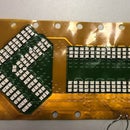Introduction: Four Ways to Remove the Solder Mask
This post is going to share how to remove the solader mask with 4 ways.
Step 1: Background
Solder Mask A heat resistant coating material applied to selected areas to prevent solder from depositing during subsequent soldering. The solder mask material can be liquid or dry film. Both types must meet the requirements of this regulation. Although the dielectric strength is not evaluated, and its performance is not satisfactory according to the definition of "insulator" or "insulating material", some solder mask formulations have certain insulation properties and are not considered for high voltage conditions. Often used as a surface insulator. In addition, the solder mask is very effective for preventing surface damage of the PCB during assembly operations.
Test points, ground pads, or even component leads that are accidentally wetted with solder masks are commonplace. However, this does not mean that these boards are definitely scrapped. There are several safe and reliable methods for removing the solder mask on the surface of the board: scraping, milling, micro-grinding and chemical stripping are the most common methods. Each has its own advantages and disadvantages, this article will make a simple comparison of these methods. Several factors are helpful in deciding which way to remove the coating. What type of solder mask is it? Where is the solder mask on the surface of the board? What is the area of the solder mask that needs to be removed? Is the board assembled or bare? These and other factors must be evaluated before determining the most appropriate removal method.(Solutions are from https://www.censtry.com/)
Step 2: Method 1: Scratching
This method is not peculiar, but the noise is large. Usually a skilled technician holds a knife, scraper or chisel to remove the solder mask from unwanted areas. This technique is the easiest to control and does not require special settings, but has the disadvantage of having a large removal area. The operator will feel tired. A mechanical eraser of the type used by drafters can speed up the process. This technique is easy to control, but the method is often used to remove the thin solder mask layer. This method can be used in conjunction with other removal methods as the final surface treatment step.
Step 3: Method 2: Milling
Have you used a milling machine to remove the solder mask? It looks extreme, but it is a very effective and accurate way to remove the solder mask. Due to the use of sharp milling cutters, depth accuracy must be controlled and the milling system requires a microscope-assisted visual inspection. Carbide vertical milling cutters are the most common type of tool because the carbide vertical milling cutter is very sharp, it can easily enter the coating and can touch the surface of the board. Rotating the milling cutter back and forth in the opposite direction is an effective way to control depth, and the skill and experience of the operator is particularly important.
Step 4: Method 3: Chemical Stripping
This method is the most effective way to remove the solder mask on the copper or post-weld surface. A protective or other protective material should be placed on the surface of the board to isolate the area to be stripped, and then a chemical release agent applied with a brush or cotton swab. Since the release agent is liquid, it is often difficult to control. The chemical acts like a paint stripper and erodes and breaks down the coating. Chemical release agents generally contain methylene chloride and are a potent solvent. The methylene chloride-based release agent not only removes the solder mask quickly, but also corrodes the substrate if it is prolonged. Care must be taken when using chemical strippers for the above reasons, and only if other alternatives are too costly or too time consuming.
Step 5: Method4: Microgrinding
This is the best technique for removing a large area of solder mask on the surface of a board. Several suppliers have been able to offer small benchtop systems specifically designed to remove coatings, pushing the abrasive material forward through a pencil-like handpiece. The abrasive material is only a friction coating, and the main step in this process is friction, which creates an electrostatic charge. If the ground circuit board is equipped with electrostatic sensitive devices, the micro-grinding system must eliminate potential electrostatic damage. In order to control the removal area, a large amount of preparation time and protection measures are usually necessary. Thorough cleaning must be performed to remove abrasive material from the board. If you are looking for a reliable product, the operator's skills and training are the most basic requirements.











